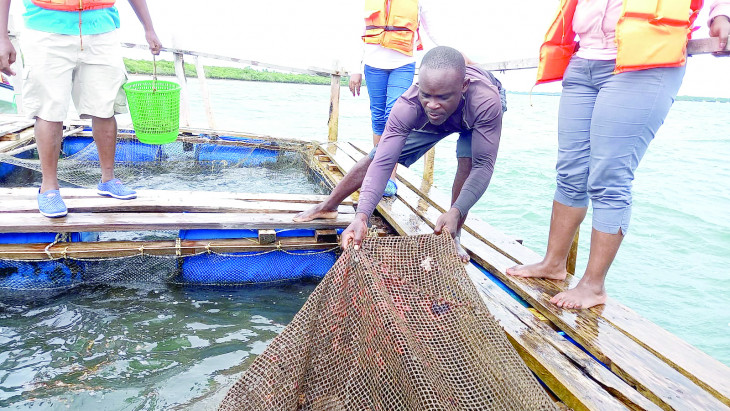Cage fishing helps free the economy of Kwale village

Villagers of Kijiweni in Shimoni, Kwale County, are turning to an innovative form of fish farming — using simple cages immersed delicately into the rich ocean waters.
The village is the first in East Africa to adopt marine fish farming using economical cages. It’s a lucrative project introduced by the Kenya Marine and Fisheries Institute (KMFRI) to spur the growth of the Blue Economy and boost the livelihood of fishermen.
Speaking during a recent interview, David Mirera, KMFRI research scientist, said cage fish farming is more efficient than the traditional net-haul form since it yields over 2,000 kilogrammes of fish per cage.
He noted that the project also ensures food security. “We introduced this technology to Kijiweni, whose economy is dependent on fishing,” Mirera said, adding that each cage accommodates 1,000 fingerlings. So far, KMFRI has made six cages for them.
“We have rabbit fish (taffi) in some of these cages. We chose that fish because of its commonality here. Many people prefer it”, he said.
Marine conservation
Unlike normal fishing, cage farming assists in marine conservation, he explained. “It is easier to trap fish in these cages, hence conserving coral reefs — which are marine breeding sites and tourist attractions,” he said.
Mathias Igulu, a scientist from Western Indian Ocean Marine Science Association, said: “The revenue realised from the South African waters to the Somali coastline is over Sh340 billion. That means there is a rich bounty in our ocean,” he noted.
Fisherman Hamadi Kombo Hamadi said they are harvesting more fish now. “In normal fishing, we had to venture deep into the sea, yet came back with less than 10kg daily. But with these cages, we rarely risk our lives in the waters, but still harvest more. The fish are attracted to the cages due to the food inside. That makes it easy to harvest them,” he said.
The technology is also practised in freshwater bodies like Lake Victoria.
Fish markets in Kenya and worldwide are under-served, pointing to a huge potential. “On average, a Kenyan eats about four kilogrammes of fish annually, against the recommended 10 kilogrammes”, he said.
The KMFRI project is targeting about 67 beach management units.












